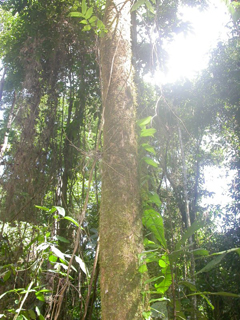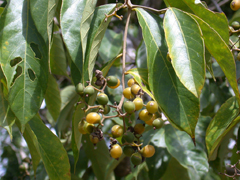 |
|
Indiana Coronado |
 |
| Smithsonian Tropical Research Institute |
Translate this page:
Summary
Cordia bicolor is a tropical, fast-growing, short-lived pioneer species with an ability to thrive under extreme environmental conditions. It is a medium-sized tree of up to 20 m tall with very small white flowers that form into dense clusters at the ends of branches. The fruits are small berries. The crown is rounded. The fruit is ovoid and edible. The wood is used as fence post and in rural construction.
Central America, Colombia, Costa Rica, Guiana, Guianas, Guyana, Panama, South America, Suriname, Venezuela.
Physical Characteristics

 Cordia bicolor is a deciduous Tree growing to 15 m (49ft) by 15 m (49ft) at a fast rate.
Cordia bicolor is a deciduous Tree growing to 15 m (49ft) by 15 m (49ft) at a fast rate.
See above for USDA hardiness. It is hardy to UK zone 10. The flowers are pollinated by Bees, butterflies, insects.
Suitable for: light (sandy), medium (loamy) and heavy (clay) soils and prefers well-drained soil. Suitable pH: mildly acid, neutral and basic (mildly alkaline) soils. It cannot grow in the shade. It prefers moist soil.
UK Hardiness Map
US Hardiness Map
Synonyms
Cordia belizensis Lundell Cordia carnosa Rusby Cordia lockhartii Kuntze Cordia trichostyla Pittier G
Plant Habitats
Edible Uses
Edible Parts: Fruit
Edible Uses:
Although we have seen no specific information for this species, the fruits of all members of this genus are said to be edible[ 422 ]. In general the fruit comprises a thin to fairly thick layer of pulpy, sweetish-tasting flesh surrounding a single seed[ 200 ]. The ovoid fruit of this species is about 12mm long and 8mm wide[ 422 ].
References More on Edible Uses
Medicinal Uses
Plants For A Future can not take any responsibility for any adverse effects from the use of plants. Always seek advice from a professional before using a plant medicinally.
None known
References More on Medicinal Uses
The Bookshop: Edible Plant Books
Our Latest books on Perennial Plants For Food Forests and Permaculture Gardens in paperback or digital formats.

Edible Tropical Plants
Food Forest Plants for Hotter Conditions: 250+ Plants For Tropical Food Forests & Permaculture Gardens.
More

Edible Temperate Plants
Plants for Your Food Forest: 500 Plants for Temperate Food Forests & Permaculture Gardens.
More

More Books
PFAF have eight books available in paperback and digital formats. Browse the shop for more information.
Shop Now
Other Uses
Fencing Pioneer Soil stabilization Wood
Agroforestry Uses: A fast-growing, short-lived pioneer species, it is able to support the harsh, adverse conditions created when the primary forest tree-cover is damaged or destroyed. Its ability to grow, even thrive, under such extreme circumstances is important to the process of forest succession. Cordia's rapid growth quickly establishes an anchoring root system as well as a sheltering crown that help to protect exposed soils and provide the more consistent regimes of humidity and temperature that are required by most other plant species[ 510 ]. Other Uses The wood is used for fence posts and in rural construction[ 333 ].
Special Uses
References More on Other Uses
Cultivation details
A tropical plant. It grows in wet and moist forests.
References Carbon Farming Information and Carbon Sequestration Information
Temperature Converter
Type a value in the Celsius field to convert the value to Fahrenheit:
Fahrenheit:
The PFAF Bookshop
Plants For A Future have a number of books available in paperback and digital form. Book titles include Edible Plants, Edible Perennials, Edible Trees,Edible Shrubs, Woodland Gardening, and Temperate Food Forest Plants. Our new book is Food Forest Plants For Hotter Conditions (Tropical and Sub-Tropical).
Shop Now
Plant Propagation
Seed - very slow to germinate, the process can be sped up if the seed is scarified by lightly abrading the seedcoat to allow easier ingress of water[ 307 ].
Other Names
If available other names are mentioned here
Cordia bicolor or Muneco
Native Range
Coming Soon
Weed Potential
Right plant wrong place. We are currently updating this section.
Please note that a plant may be invasive in one area but may not in your area so it's worth checking.
None Known
Conservation Status
IUCN Red List of Threatened Plants Status : This taxon has not yet been assessed

Growth: S = slow M = medium F = fast. Soil: L = light (sandy) M = medium H = heavy (clay). pH: A = acid N = neutral B = basic (alkaline). Shade: F = full shade S = semi-shade N = no shade. Moisture: D = dry M = Moist We = wet Wa = water.
Now available:
Food Forest Plants for Mediterranean Conditions
350+ Perennial Plants For Mediterranean and Drier Food Forests and Permaculture Gardens.
[Paperback and eBook]
This is the third in Plants For A Future's series of plant guides for food forests tailored to
specific climate zones. Following volumes on temperate and tropical ecosystems, this book focuses
on species suited to Mediterranean conditions—regions with hot, dry summers and cool, wet winters,
often facing the added challenge of climate change.
Read More
Expert comment
Author
A.DC.
Botanical References
Links / References
For a list of references used on this page please go here
A special thanks to Ken Fern for some of the information used on this page.
Readers comment
| Add a comment |
|
If you have important information about this plant that may help other users please add a comment or link below. Only comments or links that are felt to be directly relevant to a plant will be included. If you think a comment/link or information contained on this page is inaccurate or misleading we would welcome your feedback at [email protected]. If you have questions about a plant please use the Forum on this website as we do not have the resources to answer questions ourselves.
* Please note: the comments by website users are not necessarily those held by PFAF and may give misleading or inaccurate information.
To leave a comment please Register or login here All comments need to be approved so will not appear immediately.
|
|